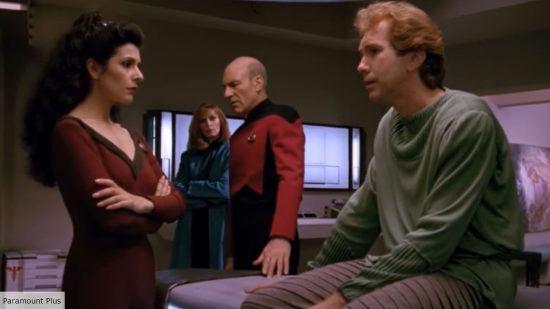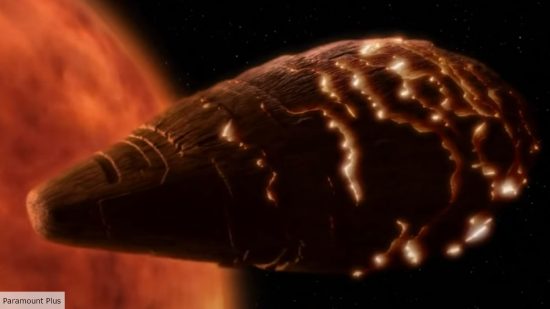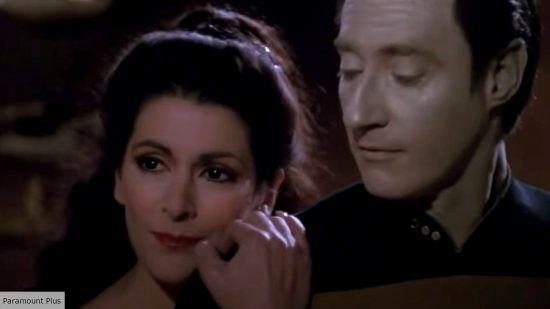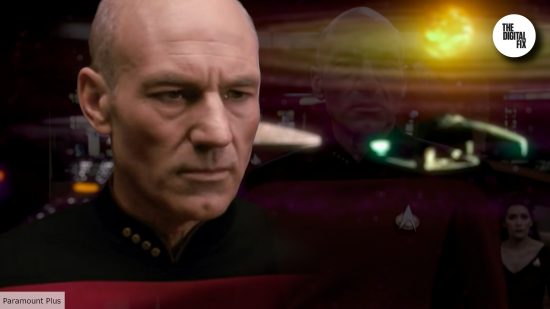‘Tin Man’ might seem like an odd choice for a “perfect” episode of Star Trek, especially coming from season three of The Next Generation. The season gave us some of the best of Trek from ‘Yesterday’s Enterprise’ and ‘The Defector’, up to the climax of ‘The Best of Both Worlds’. ‘Tin Man’, conversely, is reasonably formulaic. There are no stand-out villains or enigmatic character moments for our main crew: just a run-of-the-mill adventure with a few guest stars. I think that’s what makes it special, though.
This is a Star Trek episode where there is no gimmick or break with the norm; it stays within the very rote-like expectations and limitations of TNG and yet manages to deliver a satisfying story that stands well above many others across the Trek canon. It captures the essence of what makes The Next Generation such a rewatchable show (and one of the best TV series of all time) with the perfect combination of the personal, the political, and the extraordinary.
There are two real arcs to ‘Tin Man’. The first is the high-stakes cat and mouse with the Romulans over the féted Tin Man: an ancient living spaceship that has been discovered on the edge of explored space and could be filled with revolutionary technology beyond wonder. The other is the human story of one-off Star Trek character Tam Elbrun; the damaged Betazoid first contact expert whose incredible telepathic talent has left him isolated – and reviled – by others, left alone among a crowd.
Elbrun is, in many senses, a very typical guest star within the Star Trek The Next Generation cast. He’s a fish out of water, upsetting the finely tuned balance of our USS Enterprise-D crew and getting under their skin where he can. But, in the great Star Trek series tradition, he’s no villain. He’s on our heroes’ side, and unlike the usual smarmy bureaucrat or admiral, he’s also so much more. He’s haunted by his talent for telepathy, the constant noise of minds, and his inability to understand it all; and in that, there’s a potent example of the powerful allegory that makes Star Trek work.

Is Elbrun’s story a metaphor for neurodivergence? For social isolation? For disability? In many senses, it doesn’t matter; like all the best Trek allegories, it’s totally subjective, connecting with all possible interpretations in equal measure. This approach has its problems. We can correctly point to episodes like ‘The Outcast’ as examples of why overt representations can prove more effective than allegorical alternatives, but there’s still a reason to acknowledge and celebrate the strength of TNG’s allegories.
The final plot element is the race for Tin Man itself, and what we learn about it along the way. The Tin Man – or Gomtu as we learn it’s actually called – is every bit as fascinating a character as Elbrun (and it is a character): an ambiguous living ship that’s just as lonely as the Betazoid, and just as tired.
Trek has such a strong tradition of exploring the stranger, more wonderful aspects of science fiction, from omniscient super-beings like the Q Continuum or the Organians, to eldritch horrors like the Borg or the simple, universal fears of the Horta mother from ‘The Devil in the Dark’. Gomtu is another fascinating, mysterious example of this; it is extraordinary in how typical an entity like it is in the Trek universe.

It holds the memories and secrets of a universe long, long gone, and the painful memories of those who left it behind. But it also represents a final form of salvation for Elbrun; his constant ordeal of voices is ended as he joins Gomtu on one final journey. Where? We don’t know. Perhaps it doesn’t matter. What matters more is that their mutual lives of loneliness (both in the crowd and in the incomprehensible void) are over.
The cat-and-mouse starship confrontation that underpins this extraordinary, otherworldly story of identity and loss is textbook TNG. In some senses, it seems barely worth talking about; not when you have standout iterations of the genre like ‘Contagion’ or ‘I, Borg’, let alone ‘Darmok’, one of the best episodes of the sci-fi series. ‘Tin Man’ is nothing compared to them, really, but it does what they do so well without the genius of Tamarian storytelling or the incomprehensible terror of the Borg. Perhaps that’s even more impressive.

With malleable allegory, complex guest characters, and an alien beyond imagination, ‘Tin Man’ is peak TNG. It is not, however, the perfect episode. The Romulan appearance is a deeply secondary one; interesting perhaps, in a small sense, but shallow. They want Tin Man for his secrets, yes, but we learn little else about their ambitions. Similarly shallow is our understanding of Gomtu: we learn almost nothing about the living ship, or the civilization that created and traveled space aboard it.
Perhaps that’s the point, though. That civilization is so distant from the galaxy our characters live in that there are more questions than answers by the end of the episode. What happens to Tam? Will we ever find out who made (or grew) Gomtu?

These unanswered questions are, ultimately, what makes Star Trek so fascinating to delve into. The best stories leave so many loose threads to follow; maybe we will answer the question ourselves; maybe other Trek media – new shows, new books, audio dramas, or comics – will follow it up. Maybe a fan concluded the story themselves, in a written work or simply in a thought they share with you at a convention.
‘Tin Man’ is the platonic ideal of a Trek episode. It is still, at its very core, a story of humanity despite Romulan intrigue, and despite ancient alien living spaceships. Even the Betazoid nature of Elbrun is part of this deeply human story we are being told about belonging, fitting in, and the pain of not having a place in the world. Elbrun and Gomtu’s loneliness (separately stemming from the isolation of the crowd and the deep, painful solitude of space) is ham-fisted in some scenes, and visceral in others; but it is compelling either way.
It’s not a perfect episode – no episode of Star Trek is – but ‘Tin Man’ takes all the elements of Trek and puts them into a neat 45 minutes of tense, enjoyable (sometimes beautiful) television that sums up everything we could want from the franchise.
For more on Star Trek, you can read why we don’t care that Strange New Worlds broke canon, and why the TNG movies were always doomed to fail. Or, see our ranking of the Star Trek captains, and check out how we think each Star Trek caption would fare in a zombie apocalypse.
